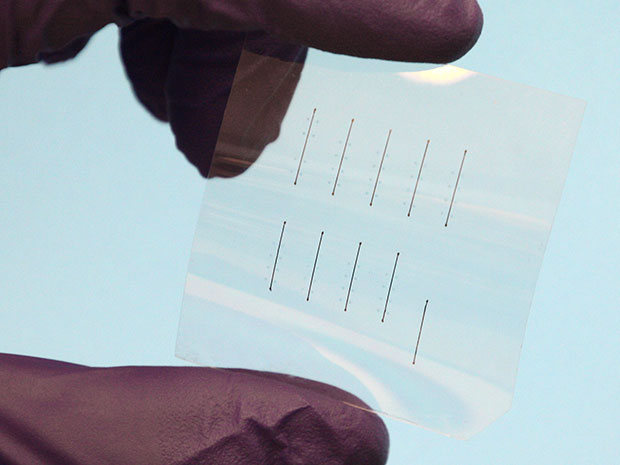On the inkjet printer printed three-bit RAM

Three-bit fast memory cells printed on a standard inkjet printer
Up to the present, two types of memory have been used in computer devices: 1) non-volatile but relatively slow flash-type memory; 2) volatile fast RAM like DRAM. But the ideal memory combines the advantages of both these types - it should be quick to write and read, but non-volatile and not to be destroyed, including from multiple read operations. It is this type of memory that is being developed by research teams of different companies. One of the suggested types of memory is Conductive Bridge RAM (CBRAM), a variation of Resistive RAM (ReRAM).
CBRAM really combines the properties of RAM and flash memory. It has a simple conductor-dielectric-conductor type structure. The CBRAM cell resistance is electrochemically modified between two states. If the appropriate voltage is applied, the metal thread forms an interconnect between the two electrodes, which corresponds to a low resistance in the ON state. The thread can be partially dissolved at another voltage, returning the cell to a high resistance state (OFF).
One of the most promising areas in the development of ReRAM is the printing of memory cells on an inkjet printer. This process does not require the use of lithography and a clean room, significantly reducing the cost of production of electronics. In addition, using a substrate of cheap film, we get a memory that is great for flexible electronics. And this greatly expands the scope of application of electronic devices.
')
Previous research in the field of memory printing on a printer focused mainly on electro-hydrodynamic printing methods . Unfortunately, at the moment all memory devices printed by standard inkjet memory technology require additional production steps, such as electroplating or lithographic structuring .
But now, physicists from the Munich University of Applied Sciences have found an inkjet method CBRAM, which does not require additional post-processing . From the printer go completely ready to use resistive RAM devices. The method is easy to adapt to the roll technology - the process of manufacturing electronic devices on rolls of flexible plastic.
A key element of ReRAM is the insulating layer, which represents the space for the migration of ions and the creation of metallic filaments. Many materials have tried this role, including Ag 2 S, ZnO, SiO 2 , GeSe and polymers, while SiO 2 showed the best switching characteristics among all .
German physicists have used Honeywell Accuglass 111 material for the insulating layer. This is a methylsiloxane polymer that contains a layer of the aforementioned SiO 2 . Several additional layers are then applied to this polymer on an inkjet printer. The researchers used the standard commercially available inkjet printer FujiFilm Dimatix Materials Printer DMP-2850 , which is used for printing different materials. In this case, you need three liquid material:
- electrically conductive layer of silver nanoparticles;
- spin glass (dielectric);
- electrically conductive organic polymer PEDOT: PSS.
The result is really flexible plates with rewritable RAM. According to the authors of the scientific work, rewriting information into such devices using an electrochemical method requires a relatively small current: 1 microamps for recording, 0.5 volts for switching to the ON state (formation of a metallic conductor) and negative voltage of –0.05 volts for switching to the OFF state .

Current strength (in nano-amperes) and voltage during recording, as well as the corresponding resistance and voltage characteristics

Voltage to go to the ON state in relation to the sintering temperature of the spin glass
Most importantly, the researchers achieved a switching speed from ON to OFF and back to 300 nanoseconds. Hence, the memory can operate at a frequency of 3.33 MHz. This is a really fast memory.
Interestingly, memory cells produced in this way are potentially multi-bit. That is, by varying the voltage, you can set a different resistance in each memory cell and thus record not only 0 and 1, but other values as well. Researchers say that each cell is capable of receiving eight well-distinguished electronic states (it turns out 000, 001, 010, 011, 100, 101, 110, and 111, that is, three bits). While it is not entirely clear how to use three-bit memory. Maybe just to increase the density of information storage.
Now the density of memory recording on the plate depends only on the resolution with which the printer is capable of printing. The DMP-2850 model prints 100 × 100 micron cells, but any improvements in inkjet technology will instantly lead to an increase in memory capacity.

One memory cell under the microscope
Scientists hope that printing flexible electronics will become as revolutionary technology as 3D printing from plastic. Anyone will be able to print a new electronic board for their home appliance, or simply reprint RAM for a personal computer if necessary.
The printed memory successfully sustained 10,000 read operations by 0.1 V.
The scientific work was published in the journal Applied Physics Letters in April 2017 (doi: 10.1063 / 1.4978664).
Source: https://habr.com/ru/post/402957/
All Articles